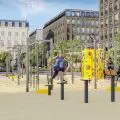Tactical urbanism, also known as guerrilla urbanism, pop-up urbanism and do-it-yourself urbanism, involves low-cost, temporary changes to urban environments to improve local places and public spaces. It's an approach to building and activating neighborhoods, using short-term, low-cost and scalable interventions that catalyze long-term change.
It's a dynamic method that enables rapid and effective improvements to urban spaces without incurring large financial expenses. It emerged as a grassroots movement and enables communities to make immediate, effective changes through short-term, scalable interventions.Projects in this vein can be initiated by citizens, organizations or governments, and often serve as prototypes for more permanent solutions. Examples include pop-up parks, temporary bicycle paths and pedestrian promenades. The movement emphasizes community involvement, rapid experimentation and the use of low-cost materials to test and refine ideas for urban projects.
A flagship example of such efforts is Times Square in New York City. In 2009, the city of New York temporarily closed part of Times Square to traffic, creating a pedestrian zone with urban furniture and vegetation. The project was so successful that it became a permanent change, significantly improving the quality of public space and pedestrian safety. It was described in more detail by Janette Sadik-Khan in her book "Fighting for the Streets. How to reclaim the city for the people."
At the opposite pole of such activities one would like to place the famous pallet installation in Warsaw's Bank Square in 2019. The derided experiment with an urban square on the site of a parking lot, however, can be categorized as tactical urbanism. But wait, after all, tactical urbanism is supposed to be cheap! Here, however, the price tag - nearly one million zlotys - is sizable. Yes, it's true, but 70 percent of the funds were used to buy things that remained in the city's property: furniture, graduation towers and pots were moved to another location. Opponents of this solution complained that it was just a closed parking lot and pallets on heated concrete. The truth, however, is that this is a perfect example of prototyping, which is not geared toward finding the perfect solution right away.
This example showed that yes, the site will attract people, but it is not enough to remove parking spaces. The environment needs to provide thermal comfort and safety, and so the traffic organization needs to change. Projects of this type have failures as well as concept changes built in. It is important to see the bigger picture of such a project and the direction of change set with such an intervention. To quote Kasia Wilk - It' s important that you can see the good (of the project), It's important that you see the enormity of it.
List of pluses
One of the key advantages of tactical urbanism is its cost-effectiveness. Projects of this type are usually low-cost, making them accessible even to communities with limited financial resources. This makes it possible to experiment without significant financial risk, which opens the way to creativity and innovative solutions to urban problems.
Tactical urbanism is also distinguished by its rapid implementation. Projects can be implemented in a matter of days or weeks, allowing for immediate impact on urban space and quick feedback. Such interventions are also extremely flexible and adaptable. They can be easily modified based on community feedback and observed results, allowing for continuous project improvement.
An important element of tactical urbanism is community engagement. These projects often involve local residents in the planning, implementation and evaluation process, which builds a sense of ownership and pride in where they live. When given the opportunity to actively participate, residents become co-creators of the space they live in.
Testing larger projects is another important aspect of tactical urbanism. It acts as a "testing ground" for larger, more sustainable urban interventions, providing valuable data and insights before making significant investments. In this way, the risks associated with larger projects can be minimized by pre-testing their effectiveness.
Tactical urbanism projects often focus on improving public spaces, making them more welcoming, pedestrian and attractive to residents. This improves the quality of life in the city and makes the spaces more accessible and pleasant to use.
The safety improvements brought by these interventions should also not be forgotten. Examples such as temporary bike lanes, pedestrian plazas and traffic calming measures can significantly improve safety for all road users.
Tactical urbanism can also bring economic benefits. Temporary installations can attract foot traffic, which in turn can increase the turnover of local businesses while demonstrating the economic value of permanent changes. In addition, such projects can introduce environmental improvements, such as through the creation of parklets, community gardens or temporary green spaces, which increases greenery and biodiversity in cities.
Another important aspect is building social capital. Collaboration on tactical urbanism projects helps establish relationships between residents, local authorities and other stakeholders, which strengthens social ties and improves cooperation within the community.
With tactical urbanism, it is also possible to respond quickly to urgent community needs without waiting for lengthy administrative processes. This method encourages creativity and innovation, as low rates of risk allow new and unusual solutions to urban problems to be tried.
Tactical urbanism is one element of contemporary awareness-raising about urban problems and initiating conversations about urban planning or community needs. These projects can direct attention to key issues and encourage broad public debate.
Finally, tactical urbanism strengthens citizen action by empowering citizens to actively shape their surroundings and promoting civic engagement. Overcoming the gap between planning and implementation is another achievement of this method, enabling a faster transition from ideas to action. By using tactical urbanism, communities can create places that are more livable and focused on local needs, while promoting a culture of active citizenship and cooperation in creating the city. Tactical urbanism often begins with grassroots initiatives by residents, which is the essence of participation.
Step by step
Both local authorities and communities can start their own initiatives. For a project to be effective, it is first necessary to identify local problems, identifying specific urban challenges in the neighborhood where small-scale interventions could benefit. The next step is to generate ideas by brainstorming creative, inexpensive solutions that can be implemented quickly.
Next, it's a good idea to form a project team by gathering a group of committed individuals, including local residents, design people. Once the team is formed, the concept should be developed, that is, a clear proposal outlining the project's purpose, design and implementation plan. The next important step is to establish contact with the office. Early and frequent communication with local government departments is crucial to get support and necessary approvals.
To make the project legal and safe, it is necessary to obtain permits, the required approvals for projects in public spaces. Then you need to plan the implementation, preparing to create the installation. It is worth developing a communication plan to inform the community about the initiative and encourage participation.
Implementation of this type of project involves the execution of interventions, often using temporary, low-cost materials. After implementation, it is important to monitor and evaluate the impact of the project, gather feedback and make changes as needed. Finally, consider long-term solutions, using the tactical urbanism project as a prototype to build support for more permanent changes. Tactical urbanism can be considered a participatory tool that can reach different levels on the participatory ladder, often reaching its highest rungs. Its strength lies in the fact that it enables real, practical involvement of residents in the shaping of urban space, which is the essence of public participation in the urban context.










